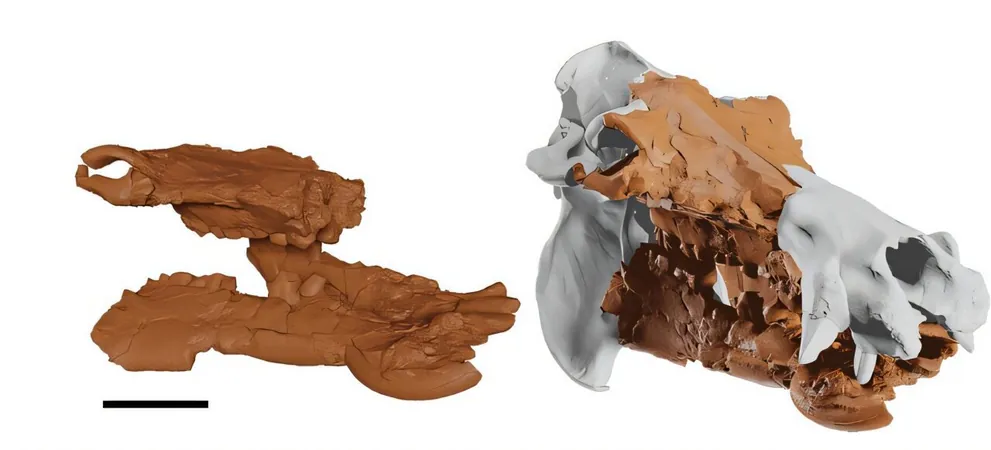
Unlocking the Mystery: Scientists Reconstruct the Skull of an Extinct Cretan Hippo!
2024-12-29
Author: Noah
Introduction
In an exciting development, researchers Nikolaos Gerakakis and Prof. Dimitrios Makris have unveiled the first complete skull reconstruction of the extinct dwarf hippopotamus, Hippopotamus creutzburgi, which once inhabited the ancient island of Crete. Utilizing cutting-edge 3D digital imaging techniques, this study, published in the journal Digital Applications in Archaeology and Cultural Heritage, provides a fascinating glimpse into a long-lost species that thrived during the Pleistocene era.
Pleistocene Habitat
The H. creutzburgi lived on Crete during the Early to early Middle Pleistocene, a time when rising and falling sea levels and land movements drastically altered the geography of the Aegean region. The researchers propose that a herd of Hippopotamus antiquus, a larger ancestor, made the journey from the Peloponnese to Crete when the seas were significantly lower, allowing them to migrate to the island.
Adaptation and Size Reduction
Gerakakis explains that these hippos, adapted to life on the island, underwent a shrinkage phenomenon known as the 'island rule,' where larger animals tend to evolve into smaller forms due to limited resources and environmental pressures. Remarkably, juvenile hippos likely had better survival rates than adults, enhancing their chances of establishing a stable population on Crete.
Speculations on Extinction
Despite flourishing for a time, the exact reasons behind the extinction of H. creutzburgi remain elusive. Speculations range from natural catastrophes and climatic changes to competition for food with newly arrived deer species. Ongoing research is aimed at uncovering these mysteries.
Fossil Discoveries
The remains of these hippos are primarily found on the Katharó plateau, an area renowned for its rich fossil deposits. However, the preservation quality of H. creutzburgi fossils is often poor, leading to many fragmented and worn-out specimens, making paleontological reconstruction quite challenging.
Reconstruction Methodology
Using a select few fossil remains excavated from 1998 to 2002, Gerakakis and Makris employed advanced photogrammetry and innovative virtual reconstruction methods in Blender—a computer graphics software. This approach allowed them to manipulate the fragmented skull without causing damage to the actual fossils. By adhering to the retrodeformation methodology, they crafted a 'spider-like' exoskeleton system that facilitated precise reconstructions.
Morphological Insights
The team discovered that the morphology of H. creutzburgi closely resembles that of African hippos and even smaller, dwarf varieties found in Madagascar. They estimate that this ancient hippo was roughly the size of a juvenile male African hippopotamus.
Future Plans
But there's even more to come! The digital reconstruction has practical applications; it can be 3D-printed for educational purposes and museum exhibitions, including an upcoming display at the Katharó plateau.
Conclusion
Fascinated by this groundbreaking work, Gerakakis also revealed that they are currently in the process of publishing a detailed reconstruction of the entire skeleton of H. creutzburgi. With most skeletal elements recovered, they hope to shed further light on this ancient species, highlighting not only its anatomical structure but also its evolutionary saga.
Significance of the Study
This remarkable study invites curiosity about the ancient ecosystems of Crete and reminds us of the biodiversity that once flourished on this Mediterranean island. Stay tuned for more revelations as research continues into this captivating prehistoric world!









 Brasil (PT)
Brasil (PT)
 Canada (EN)
Canada (EN)
 Chile (ES)
Chile (ES)
 Česko (CS)
Česko (CS)
 대한민국 (KO)
대한민국 (KO)
 España (ES)
España (ES)
 France (FR)
France (FR)
 Hong Kong (EN)
Hong Kong (EN)
 Italia (IT)
Italia (IT)
 日本 (JA)
日本 (JA)
 Magyarország (HU)
Magyarország (HU)
 Norge (NO)
Norge (NO)
 Polska (PL)
Polska (PL)
 Schweiz (DE)
Schweiz (DE)
 Singapore (EN)
Singapore (EN)
 Sverige (SV)
Sverige (SV)
 Suomi (FI)
Suomi (FI)
 Türkiye (TR)
Türkiye (TR)
 الإمارات العربية المتحدة (AR)
الإمارات العربية المتحدة (AR)